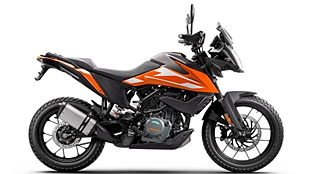

It even boats an analogue compass, which some would argue you don’t actually need, but it’s very much in line with the bike’s charming simplicity, so why not? The non-adjustable windshield is carried over, too. The cockpit remains unchanged, but given it’s still the most modern-looking dash ever to come off Royal Enfield’s production line, why change it? It’s got all the information a bike like this needs in the form of a couple of trip metres, a clock, both fuel and engine temperature gauges, as well as an analogue tacho and speedo readout.

Aided undoubtedly by the well-balanced chassis designed by Harris Performance, the suspension kept the 250kg bike-and-rider combo both plumb and planted. The no-name suspension package behaved intuitively in all conditions, but it was through the fast and twisty road sections, where the surface was really bumpy and we were left with little time to react, that the non-adjustable 41mm conventional fork and the monoshock, adjustable only for preload, really showed their mettle. Though if you owned it, you’d shorten the sidestand and remove the centre-stand, increasing mid-corner ground clearance while also reducing weight. It’s a forgivable trait on the first model, but something that really should have been rectified by now. The centrestand is handy, however, given that the sidestand is probably 20mm too long to allow you to park it wherever you stop without concern that it’ll topple over, and it’s not helped by the sag in the rear shock at rest. And the tall gearing means you don’t miss the sixth ratio on the five-speed gearbox, either. It’s not something I noticed as much on the first model and, considering the chassis and running gear are unchanged, that has to be down to the confidence dished out by this model’s Pirelli MT-60 tyres as opposed to the original model’s CEAT-branded hoops.ĭespite the 90/90-21 dimensions of the front tyre, there’s plenty of feedback through the one-piece handlebar, allowing you to get the most out of the 24.5hp/32Nm single-cylinder engine through the tight and twisty roads. Its 220mm of ground clearance and 200mm/180mm of front and rear suspension travel was ample for the off-road stuff, but when the pace hotted up on the tarmac the Himalayan’s centrestand was the first thing to touch down, digging itself into the asphalt relatively early. Its accessible 800mm seat height (and the bash plate fitted as standard) takes away any of the anxiety sometimes associated with go-anywhere riding. The fuel injection improves this, of course, but the cold-blooded hallmarks remain, the new model isn’t always happy to idle if it isn’t completely up to operating temperature. The outgoing model was extremely cold-blooded, taking a couple of thumbs of the starter on a cold morning and a long time to warm up. Even when it was carburetor-fed, it could boast a frugal 3.6lt/100km so would-be owners can expect north of 300km between fuel stops. Its 15-litre tank and new-for-2020 electronic fuel injection also makes for some decent range, too. But braking was the only place I could notice the extra heft. Okay, some of that is down to the test bike still being fairly new, but there’s plenty of room for improvement, even in this relatively low price point where the Himalayan falls.Īnd the fact that the ABS system adds an extra 9kg to the bike’s overall kerb weight, taking it to 191kg compared to the outgoing model’s 182kg, does nothing to improve the brake package’s effectiveness. Out on the road, even when using the front and rear brakes in unison and with decent force, the ByBre (Brembo’s Indian-based subsidiary) braking package lacks a bit of both feel and power. I wasn’t going quick, to be fair, and using a combination of first- or second-gear engine braking and front and rear brake, it rolled down even the steepest sections in a predictable and manageable way.Īdmittedly, the stopping bit could have been far more efficient. The system didn’t impede on the slow and technical descents on rocky surfaces, either. I stamped on the rear brake as I slowed on a gravel road, the rear wheel locked-up for a millisecond or two before the system intervened, keeping the wheel in motion before bringing me to a complete stop.

It’s a Bosch system, which adds all of the necessary confidence on the road, whether sealed or well-maintained gravel, and it’s really predicable in its activation. But after spending a couple of days on the updated bike in all sorts of conditions ranging from snotty, rocky hills through to fast, flowing tarmac, I learnt pretty quickly that in an application such as the Himalayan, not having a switchable anti-lock braking system doesn’t actually matter.


 0 kommentar(er)
0 kommentar(er)
